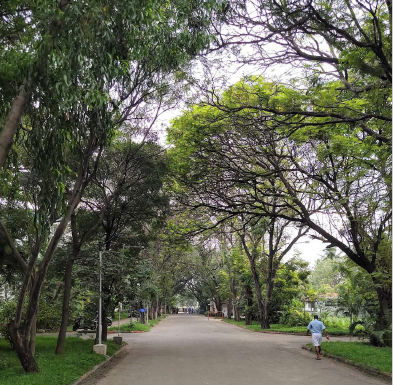Sustainability, Cataract
Tackling Carbon Emissions from Cataract Surgery
Green campus sequestration shown an effective part of the solution. Cheryl Guttman Krader reports from Milan.

Cheryl Guttman Krader
Published: Wednesday, November 9, 2022
A novel green campus design at the Sankara Eye Hospital in Coimbatore, India, aims to offset the carbon footprint associated with the huge volume of cataract surgeries the institution performs each year, reported Atul Kamath MD.
“Global warming is one of the largest threats of the 21st century, and healthcare facilities are a main contributor to carbon emission that leads to global warming,” Dr Kamath said. “With an average of 32,000 to 33,000 small-incision cataract surgeries (SICS) performed annually at our tertiary eye hospital, the carbon dioxide (CO2) equivalent and carbon footprint are highly significant and will have a tremendous impact on the environment and global warming.
“With the humongous green cover of our campus, along with maximum recycling and reusing of the generated waste and minimal usage of disposables, we are able to arrest this burden with ease,” he continued. “Thus, we believe that our tertiary eye care centre has become a model health setup for arresting [the growth of] the carbon footprint and mitigating global warming.”
To assess the environmental benefit of the green campus, Dr Kamath and colleagues conducted a retrospective observational study in which they determined the carbon emissions produced by SICS procedures performed between March 2018 and April 2019. Then they compared that figure to the amount of CO2 consumed by the green cover.
The computations for determining the number of carbon emissions produced considered all the materials used during a standard SICS procedure, including drapes, syringes, and other plastic derivatives; the estimated lifespan and weight of each tool and surgical instrument; and the waste products consumed by patients during their stay, such as pharmaceuticals, medical equipment, paper, ink, food, and information technology. An online tool calculated the produced CO2 equivalent.
The results showed that each case of SICS measured from the time of surgical procedure until patient discharge generated an average of 310 g of waste, resulting in a total CO2 equivalent of 3.2 kg. Considering the 32,073 SICS cases performed during the study period, the total generated CO2 amounted to 113.13 tonnes.
The carbon sequestration calculations showed that the carbon fixation of all the trees on the campus totalled 36.3 tonnes of carbon per year, which translated into fixation of 133.22 tonnes of CO2.
LEAFY LAYOUT
During his presentation, Dr Kamath illustrated the campus’s green cover with a series of pictures and described its features. Dr Kamath said the part of campus encompassing the medical centre measures five acres. Only one acre covers the hospital itself—the hospital, developed area, and roads. The green campus accounts for the remaining four acres.
Within the green campus, there are 55 fully grown trees representing several different varieties—as well as 100 coconut trees in the outermost periphery adjacent to the compound wall and more than 200 ornamental plants. In addition, the institution has implemented the Miyawaki method of plantation to mitigate the campus’s CO2 equivalent.
“The cumulative carbon fixation of all the trees per year is 36.3 tonnes of carbon, which in turn indicates a fixation of 133.22 tonnes of CO2. One hundred percent of 113.13 tonnes of CO2 produced by operating 32,073 SICS in our hospital was completely absorbed by the green cover in the campus.”
Atul Kamath MD is senior ophthalmology resident, Yenepoya Medical College, Mangalore, India. dratulkamath29@gmail.com
Acknowledgement: Sankara Eye Hospital and team, Coimbatore, Dr Dhananjay Bhosale and Dr Aditi Pai.

Tags: 40th Congress of the ESCRS
Latest Articles
Organising for Success
Professional and personal goals drive practice ownership and operational choices.
Update on Astigmatism Analysis
Is Frugal Innovation Possible in Ophthalmology?
Improving access through financially and environmentally sustainable innovation.
iNovation Innovators Den Boosts Eye Care Pioneers
New ideas and industry, colleague, and funding contacts among the benefits.
José Güell: Trends in Cornea Treatment
Endothelial damage, cellular treatments, human tissue, and infections are key concerns on the horizon.
Making IOLs a More Personal Choice
Surgeons may prefer some IOLs for their patients, but what about for themselves?
Need to Know: Higher-Order Aberrations and Polynomials
This first instalment in a tutorial series will discuss more on the measurement and clinical implications of HOAs.
Never Go In Blind
Novel ophthalmic block simulator promises higher rates of confidence and competence in trainees.
Simulators Benefit Surgeons and Patients
Helping young surgeons build confidence and expertise.